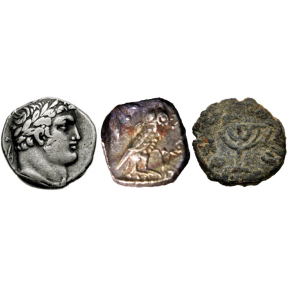Thou Shalt Not!!!
Here is an interesting historical quiz written by my friend, author and numismatist David Wray:
“…make unto thee any graven image!” Everyone knows that Jews in the days of Jesus strictly observed the Ten Commandments, including not making “any likeness of anything that is in heaven above, or that is in the earth beneath.” So here’s a test! Can you distinguish ancient Jewish coins from ancient non-Jewish coins?
Here are three different ancient coins. The first one portrays the god Melqart (a Phoenician equivalent of Herakles i.e., Hercules), the second one portrays an owl (a symbol of the goddess Athena), and the third one portrays a Jewish menorah i.e., the “candelabra” described in the Book of Exodus (25:31-40). Which of these is the oldest known Jewish coin? Which was the preferred coin 2000 years ago for payment of the Temple Tax? Which is a non-Jewish coin that Jews of Jesus’ day would have considered sacrilegious?
BONUS QUESTION: Which coin was minted in Jerusalem?
Many of us think we understand how Jews lived in ancient times, but how closely do our ideas match reality? First century Jewish historians (i.e., Philo and Josephus) portrayed Jews as vigilantly opposing the entrance of sacrilegious images into Jerusalem.
Does this help you to determine which of these coins is Jewish?
Here are the answers:
Oldest Jewish Coin: In ancient times, the “Athenian Owl,” which portrays the goddess Athena on the “heads” side and an owl on the “tails” side, served as the world’s first international currency. From Egypt to Afghanistan, almost every city-state that participated in international trade minted Athenian owls. Jerusalem was no exception. Owls of different types circulated throughout Judaea. Possibly the oldest Jewish coin, the owl coin above was minted sometime before 400 BCE.
Preferred Payment for the Temple Tax: According to Exodus 30:13 every male Jew, twenty years or older, paid one-half shekel every year to the Jerusalem Temple. Approximately 2000 years ago, the Jerusalem Temple preferred the tax to be paid with a “Tyrian” half-shekel, the coin on the left. The half-shekel in the picture was minted approximately the same year that Jesus was crucified. There is no record of Jewish priests objecting that the “heads” side of the coin portrayed Melqart and the “tails” side portrayed an eagle, which symbolized Zeus.
Non-Jewish Sacrilege: The coin on the right portraying a Jewish menorah was minted under the authority of the Umayyad caliphate sometime between 695 and 750 CE. In the time of Jesus, approximately 700 years earlier, most Jews were reluctant to put any non-abstract images on coins, especially those related to the Jerusalem Temple.
Bonus Question: By now you must have guessed, all three coins were minted in Jerusalem!
The coin images were provided courtesy of the Classical Numismatic Group, Inc. (See www.cngcoins.com.)


